Family
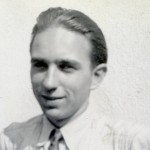
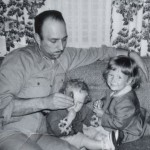 Some men are Boy Dads, which in no way means that they wouldn’t be good with girls. Some men are Girl Dads, which in no way means that they wouldn’t be good with boys. the truth is that any good dad can be a good dad to boys or to girls, but there is one thing that I think my sisters and I would all agree on with our dad, Allen Spencer. While he would have been a great dad to boys, his girls needed him to be our dad. Maybe a girl dad or a boy dad is just blessed with the gift of one or the other, because they have a particular way with one or the other.
Some men are Boy Dads, which in no way means that they wouldn’t be good with girls. Some men are Girl Dads, which in no way means that they wouldn’t be good with boys. the truth is that any good dad can be a good dad to boys or to girls, but there is one thing that I think my sisters and I would all agree on with our dad, Allen Spencer. While he would have been a great dad to boys, his girls needed him to be our dad. Maybe a girl dad or a boy dad is just blessed with the gift of one or the other, because they have a particular way with one or the other.
Our home was filled with so much love and dad understood the needs of girls…like giving up the bathroom quickly so we could get all dolled up. He understood that when camping, the fire needed to be kept going…”to keep the bears away.” There were so many other things that Dad instinctively knew about girls and our girly ways, and he always made us feel loved, special, and safe. We were his princesses, and Dad loved all his 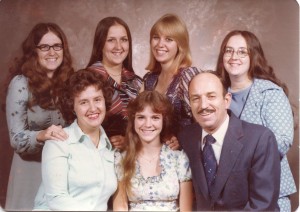 princesses and much as he loved his queen, our mom Collene Spencer. Yes, our dad was definitely a Girl Dad, but it was we, his girls, who were blessed because he was our Girl Dad.
princesses and much as he loved his queen, our mom Collene Spencer. Yes, our dad was definitely a Girl Dad, but it was we, his girls, who were blessed because he was our Girl Dad.
Dad did all the normal “dad things” that all dads do, like working hard every day to support his family, taking us on more vacations that almost any of our classmates got to go on, and I’m not bragging, just stating a fact. Dad loved to travel, and he loved this country; and he wanted his girls to be able to see as much of it as possible, because there is no greater nation on earth, except God’s chosen nation…Israel, and I think he would have loved to take us there too. For our dad, the greatest gift he could give his girls is the gift of faith in Jesus as our Savior. Faith was something he was given as a child, and I remember reading his letters home from World War II, written to his mom, Anna Spencer, in which he and his mother encouraged each other with God’s promises, given to us all in the Bible. Dad was very protective of his mom too. She was another of the women in his life who were blessed to know the love and protective nature that was always our dad, her son.
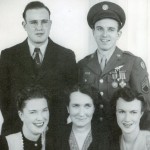
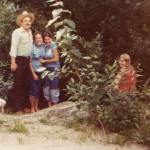
Dad went home to Heaven on December 12, 2007, and we miss him every day. There was so much more to Dad than the things he gave us or the special way we were treated, there was the love that dad gave his girls. Dad may have been blessed to be a Girl Dad, but it was really his girls who were blessed, because he was our dad. Today would have been Dad’s 98th birthday. Happy birthday in Heaven, Dad. Have a great party with Mom and the rest of the family. We can’t wait to see you all again. We love and miss you very much.

 My grandnephew, Zack Spethman is the second child of my niece, Jenny Spethman and her husband, Steve Spethman. Zack is his older brother, Xander’s big little brother…standing several inched taller than Xander. Nevertheless, the height thing has never really been a big deal to them. They are best friends, and Zack hangs out with Xander and all Xander’s friends. Zack is so easy to get along with that for Xander he seems more like a friend, and for Xander’s friends, Zack is one of the guys.
My grandnephew, Zack Spethman is the second child of my niece, Jenny Spethman and her husband, Steve Spethman. Zack is his older brother, Xander’s big little brother…standing several inched taller than Xander. Nevertheless, the height thing has never really been a big deal to them. They are best friends, and Zack hangs out with Xander and all Xander’s friends. Zack is so easy to get along with that for Xander he seems more like a friend, and for Xander’s friends, Zack is one of the guys.
As much as Zack likes to hang out with the guys, Zack really is a homebody. and is very comfortable in his own company. I can totally relate to that, because I am much the same. I think it comes from being a deep thinker. We tend to spend a lot of time in our own head…thinking things over, dreaming our own dreams, and planning the future. A person like that really likes, and needs, quiet time by himself. Many people don’t understand a “homebody/comfortable in his own company” kind of person, especially when, like Zack, they are also very 
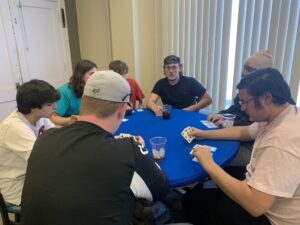 much able to be very social…and I’ll admit that it is an unusual combination. Most people who are homebodies, are also introverts, and they really don’t want to be in social situations, but Zack is totally comfortable in either situation. He is really not an introvert at all, but rather a guy with a lot on his mind.
much able to be very social…and I’ll admit that it is an unusual combination. Most people who are homebodies, are also introverts, and they really don’t want to be in social situations, but Zack is totally comfortable in either situation. He is really not an introvert at all, but rather a guy with a lot on his mind.
Zack got into a welding class this year and has really come into his own. His dad told me that it gives him a reason to go to school. He has got into welding and is really loving it. That reminds me of my dad, his great grandpa, Allen Spencer, who was also a welder. It seems to be in their blood. Zack’s cousin, Garrett Stevens also took after his grandpa and is a welder. It’s a good career move, if that’s what Zack chooses to do.
Zack and his friends, like most kids these days, like to play video games, and air soft gun hunting games. Paintball is like hand-to-hand combat, I suppose, but without the death factor. They used to use paintball guns, but I’m told it hurts some, so now they use air soft guns. Zack and his siblings, Xander, Isaac, and Aleesia have 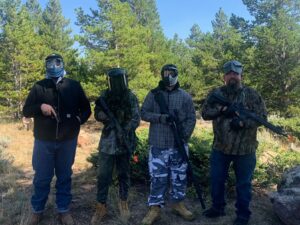
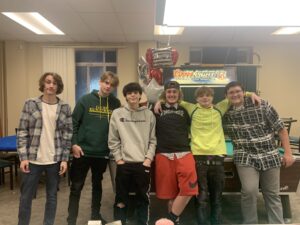 all been trained on guns and shooting. They know safety and have a healthy respect for life and the dangers of being careless with a gun. They hunt and the boys have all passed hunter safety courses (Aleesia is too young)., so even though they don’t shoot at people with a gun, the air soft gun is a fun way to do something a little different, and they love it. Today is Zack’s 17th birthday. Happy birthday Zack!! Have a great day!! We love you!!
all been trained on guns and shooting. They know safety and have a healthy respect for life and the dangers of being careless with a gun. They hunt and the boys have all passed hunter safety courses (Aleesia is too young)., so even though they don’t shoot at people with a gun, the air soft gun is a fun way to do something a little different, and they love it. Today is Zack’s 17th birthday. Happy birthday Zack!! Have a great day!! We love you!!
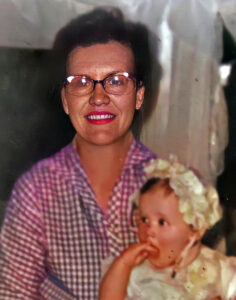
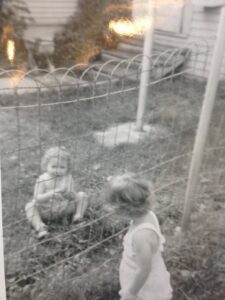 When my mom, Collene Spencer got married, she and my dad, Allen Spencer, for their honeymoon, moved to Superior, Wisconsin. While mom grew up in a big family, and knew how to cook, moving to a new area was a way to experience new foods. Mom was a little lonely when she first moved to Wisconsin, but when she arrived, she found her new best friend, her sister-in-law, Doris Spencer. They actually lived across the yard from each other. There wasn’t an alley between them, just a fence. It was a very cozy place for the two families, and as the kids came along, it made it easy to play without worrying about the little ones getting out into the street.
When my mom, Collene Spencer got married, she and my dad, Allen Spencer, for their honeymoon, moved to Superior, Wisconsin. While mom grew up in a big family, and knew how to cook, moving to a new area was a way to experience new foods. Mom was a little lonely when she first moved to Wisconsin, but when she arrived, she found her new best friend, her sister-in-law, Doris Spencer. They actually lived across the yard from each other. There wasn’t an alley between them, just a fence. It was a very cozy place for the two families, and as the kids came along, it made it easy to play without worrying about the little ones getting out into the street.
During the frequent luncheons Aunt Doris and my mom had, Mom saw that Aunt Doris was an amazing cook, and she loved many of the recipes Aunt Doris made, and so she asked for these recipes. Our whole family grew to love those dishes too which Aunt Doris continued to make for us whenever we visited in the years after we moved to Wyoming. We usually went out for dinner when we were there, but there were three recipes she made and all of us loved, and still love today. Those recipes were Stuffed Tomatoes (Aunt Doris’ special version, which I still can’t resist) and the Carrot/Chicken Salad on Lettuce with Picnic Sticks (crunchy potato sticks), the third was Chicken Noodle Casserole. It was similar to Tuna Noodle Casserole, and while I love Tuna Noodle Casserole, my sister Cheryl Masterson thinks the Chicken Noodle Casserole was way better!! Those were Aunt Doris’s recipes. She made them up or greatly improved on an old recipe she knew of.
Trips to visit Aunt Doris and Uncle Bill, were always special. They had a big house, and we had a great time. 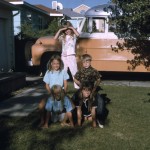
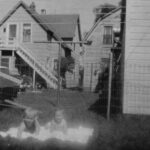 Aunt Doris and Uncle Bill always gave our parents their room. My sisters and I were never sure where they slept, but I almost think it might have been cots in the basement. Cheryl and our cousin, Pam were best friends, so Cheryl slept in Pam’s room. The rest of us slept in various places, mostly in the bus our Uncle Bill had converted into a motorhome. They could have had us stay in a motel, but they wanted us close, so we had more time to visit. The upper level of their home had been turned into a rental, and there were various renters in there, but if it was empty, we stayed there.
Aunt Doris and Uncle Bill always gave our parents their room. My sisters and I were never sure where they slept, but I almost think it might have been cots in the basement. Cheryl and our cousin, Pam were best friends, so Cheryl slept in Pam’s room. The rest of us slept in various places, mostly in the bus our Uncle Bill had converted into a motorhome. They could have had us stay in a motel, but they wanted us close, so we had more time to visit. The upper level of their home had been turned into a rental, and there were various renters in there, but if it was empty, we stayed there.
We often got to Superior, late at night…sometimes waking them up. It didn’t matter, because when we arrived, they would all get up and Aunt Doris would make us all a little snack before everyone settled into bed. Of course, we were probably up for quite a while before we were finally able to settle down. We laughed and talked continuously with Aunt Doris because she made everything fun!! She and Mom together just had so much fun. They were forever best friends. Aunt Doris had a beautiful home, and yet she was very tolerant of our noise and nonsense. We don’t ever remember her ever yelling at us or getting upset with us…Ever!! She loved us and she was always genuinely glad to see us. We all loved Aunt Doris so much that even after she and Uncle Bill divorced, we never felt like she was no longer our aunt. In fact, when our dad became ill in Canada, my sisters Caryl, Alena, Allyn, and I went up to be with him, our mom, and sister, Cheryl. Allyn needed a copy of her birth certificate to enter Canada (Pre-passport requirement). We needed to get on the road, so we had it sent 
 to Aunt Doris. We got to her house at around 4:00am, and without even knocking on the door, she knew we were there. She got up and made us breakfast…a big breakfast!! Aunt Doris was and is always the same with us. She is our aunt, and we love each other. For her and for us, that has always remained the same. And it always will!! Today is Aunt Doris’ 98th birthday. Happy birthday Aunt Doris!! Have a wonderful day!! We love you!!
to Aunt Doris. We got to her house at around 4:00am, and without even knocking on the door, she knew we were there. She got up and made us breakfast…a big breakfast!! Aunt Doris was and is always the same with us. She is our aunt, and we love each other. For her and for us, that has always remained the same. And it always will!! Today is Aunt Doris’ 98th birthday. Happy birthday Aunt Doris!! Have a wonderful day!! We love you!!

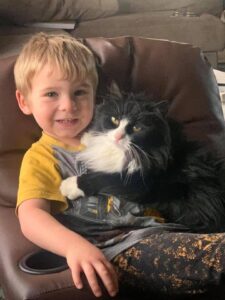 My grandnephew, Bowen Parmely is the only boy among the four children of his parents, Ashley and Eric Parmely. Bowen was the third child, and when he was born, Ashley and Eric found out, in no uncertain terms, just how different little boys are from little girls. Bowen is full of energy and, well…zing!! He lights up a room with his smile and laughter, and he is a delight to his parents, but he isn’t above picking on his sisters, Reagan, Hattie, and little Maeve. Just give him a reason…or don’t!! He really doesn’t need a reason, he is a boy, after all.
My grandnephew, Bowen Parmely is the only boy among the four children of his parents, Ashley and Eric Parmely. Bowen was the third child, and when he was born, Ashley and Eric found out, in no uncertain terms, just how different little boys are from little girls. Bowen is full of energy and, well…zing!! He lights up a room with his smile and laughter, and he is a delight to his parents, but he isn’t above picking on his sisters, Reagan, Hattie, and little Maeve. Just give him a reason…or don’t!! He really doesn’t need a reason, he is a boy, after all.
Bowen likes everything his daddy and his grandpa like. Working on tractors, however, that is top notch for Bowen. Eric has a big tractor, and Bowen would like nothing more than to be on that tractor all day long. His Aunt Brenda Schulenberg even found him a quilt that has tractors all over it last year. Talk about a happy boy. He loved it. Bowen is a farm boy, with all the trimmings. His family raises horses, cows, goats, chickens, turkeys, pigs, cats, and dogs…
 and speaking of dogs, Bowen’s parents have let each of the kids get their own dog…when they turn 7 years old. That means that Bowen’s older sisters, Reagan and Hattie each have their own dog, that is also their responsibility, and Bowen can’t wait until he is old enough to have his own dog too. Unfortunately for Bowen, that day won’t come for two more years. Until then, he will have to settle for the family dogs.
and speaking of dogs, Bowen’s parents have let each of the kids get their own dog…when they turn 7 years old. That means that Bowen’s older sisters, Reagan and Hattie each have their own dog, that is also their responsibility, and Bowen can’t wait until he is old enough to have his own dog too. Unfortunately for Bowen, that day won’t come for two more years. Until then, he will have to settle for the family dogs.
Bowen really loves all the animals, but he loves the babies the best. On a farm, with a lot of animals, there are always babies coming, and that is ok with Bowen. It is something he shares with his mom. Ashley would have tons of babies too…human and animal. The mothering instinct is very strong in Ashley, and she loves to teach 
 their kids about the animals, life, and how to grow both. The Parmely house is always filled with love, laughter, kids, and animals. When we go out there for family dinners, once a month, it is sure to be fun filled. The kids have a playroom/classroom off of the kitchen (Ashley homeschools the kids, but they did preschool in town which is where Bowen currently goes), so we can observe all the fun, as well as the occasional “turkey at the window” visits. All the kids are very entertaining, but watching Bowen, so full of energy, bouncing around the room on his bouncy horse is always super fun. Today is Bowen’s 5th birthday. Happy birthday Bowen!! Have a great day!! We love you!!
their kids about the animals, life, and how to grow both. The Parmely house is always filled with love, laughter, kids, and animals. When we go out there for family dinners, once a month, it is sure to be fun filled. The kids have a playroom/classroom off of the kitchen (Ashley homeschools the kids, but they did preschool in town which is where Bowen currently goes), so we can observe all the fun, as well as the occasional “turkey at the window” visits. All the kids are very entertaining, but watching Bowen, so full of energy, bouncing around the room on his bouncy horse is always super fun. Today is Bowen’s 5th birthday. Happy birthday Bowen!! Have a great day!! We love you!!
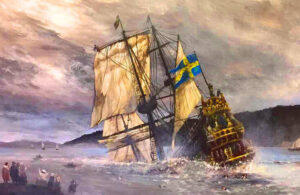
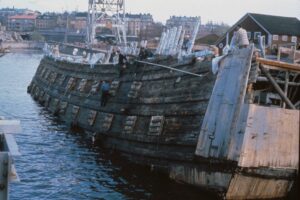 Vasa is a beautiful Swedish warship built between 1626 and 1628. For a warship, the ship was anything but plain. It was a very ornate, which is odd for a warship…at least as we see them today. The ship was built on the orders of the King of Sweden Gustavus Adolphus as part of the military expansion he initiated in a war with Poland-Lithuania, which took place between 1621–1629. Vasa was constructed at the navy yard in Stockholm under a contract with private entrepreneurs in 1626–1627. The ship was armed primarily with bronze cannon cast in Stockholm specifically for the ship. The king had her richly decorated as a symbol of his ambitions for Sweden and for himself. When she was done…she was not only stunningly beautiful, but she was also one of the most powerfully armed vessels in the world. All that was great, but Vasa was also dangerously unstable, with too much weight in the upper structure of the hull. That fact didn’t faze the king, who despite the lack of stability, of which he was informed, ordered Vasa to sea.
Vasa is a beautiful Swedish warship built between 1626 and 1628. For a warship, the ship was anything but plain. It was a very ornate, which is odd for a warship…at least as we see them today. The ship was built on the orders of the King of Sweden Gustavus Adolphus as part of the military expansion he initiated in a war with Poland-Lithuania, which took place between 1621–1629. Vasa was constructed at the navy yard in Stockholm under a contract with private entrepreneurs in 1626–1627. The ship was armed primarily with bronze cannon cast in Stockholm specifically for the ship. The king had her richly decorated as a symbol of his ambitions for Sweden and for himself. When she was done…she was not only stunningly beautiful, but she was also one of the most powerfully armed vessels in the world. All that was great, but Vasa was also dangerously unstable, with too much weight in the upper structure of the hull. That fact didn’t faze the king, who despite the lack of stability, of which he was informed, ordered Vasa to sea.
Vasa’s maiden voyage was an exciting moment for everyone in the area. On August 10, 1628, she set sail from the Stockholm navy yard and after encountering a wind that was barely stronger than a breeze, she sank after sailing roughly 1,400 yards. Seriously, that has to be the shortest maiden voyage on record…for all time. Vasa quickly fell into obscurity after most of her valuable bronze cannon were salvaged in the 17th century, which is odd, because they knew where she was and if they were able to pull the cannon up, why would they not take anything else. Nevertheless, she sat there until she was once again located in the late 1950s in a busy shipping area in Stockholm harbor. Amazingly, the ship was salvaged with a largely intact hull in 1961. She was temporarily housed in a museum called Wasavarvet (“The Vasa Shipyard”) until 1988, when she was moved permanently to the Vasa Museum in the Royal National City Park in Stockholm. Today, the ship is one of Sweden’s most popular tourist attractions. Since her recovery and placement in 1961, over 35 million visitors have seen the ship. Vasa has become a widely recognized symbol of the Swedish Empire…something I’m not sure I would like if I were the king, because while she is beautiful, she is unstable, and what leader would want “a lack of stability” to be part of their nation’s symbol.
It is said that the order to sail was the result of a combination of factors. The king, who was leading the army in Poland at the time of her maiden voyage, was impatient to see her take up her station as flagship of the reserve squadron at Älvsnabben in the Stockholm Archipelago, being the biggest one. Unfortunately, the king’s subordinates lacked the political courage to openly discuss the ship’s problems or to push to have the maiden voyage postponed. Of course, there was an inquiry by the Swedish Privy Council to find out who was responsible for the disaster. Nevertheless, in the end, no one was punished.
When the recovery crew went in to bring Vasa and her contents to the surface once again in 1961, they found thousands of artifacts, among them many items of clothing, weapons, cannon, tools, coins, cutlery, food, drink 
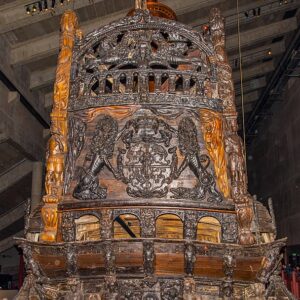 and six of the ten sails. Marine archaeologists also found the remains of at least 15 people in and around Vasa’s hull. The artifacts and the ship herself have provided scholars with invaluable insights into details of naval warfare, shipbuilding techniques, and everyday life in early 17th-century Sweden. Without question, Vasa is the world’s best preserved 17th century ship. The wreck of Vasa continually undergoes monitoring and further research on how to preserve her.
and six of the ten sails. Marine archaeologists also found the remains of at least 15 people in and around Vasa’s hull. The artifacts and the ship herself have provided scholars with invaluable insights into details of naval warfare, shipbuilding techniques, and everyday life in early 17th-century Sweden. Without question, Vasa is the world’s best preserved 17th century ship. The wreck of Vasa continually undergoes monitoring and further research on how to preserve her.

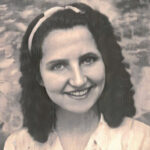 My aunt, Deloris “Dee” Johnson was always so sweet and kind. She loved to laugh, and to make people laugh. She and my mom, Collene Spencer were sisters, and they were close. I think it was probably because they were so much alike. Both of them tried to bring happiness into the day of those around them. If that meant they acted silly, then they acted silly. They were really both “crowd pleasers,” but my mom was the younger of the two, so she learned it from her older sister, I’m sure.
My aunt, Deloris “Dee” Johnson was always so sweet and kind. She loved to laugh, and to make people laugh. She and my mom, Collene Spencer were sisters, and they were close. I think it was probably because they were so much alike. Both of them tried to bring happiness into the day of those around them. If that meant they acted silly, then they acted silly. They were really both “crowd pleasers,” but my mom was the younger of the two, so she learned it from her older sister, I’m sure.
Aunt Dee was one of the kindest people you would ever want to meet. She never said a harsh word to anyone, and even her voice had a soothing way about it. Her tone was soft and soothing, and she had a smile to match. Aunt Dee loved to show her siblings new things. Once she and my mom got into a big coat, and let the wind take them for a ride…well, a run, but it made them feel free as birds. Aunt Dee was always taking the kids out for adventures. She loved the outdoors and had a great imagination, so she could entertain the younger children, and the adventures were always lots of fun. Aunt Dee taught her younger siblings how to dance, a dance she learned in school, and she also bought the family a piano. I don’t know if any of them learned to play it, but the grandkids sure enjoyed pounding on it whenever we were there.
Aunt Dee and my mom got together at our house quite often as adults, and we all loved it when she came over. It was such a treat to have her visit. She never got annoyed with us, Mom’s five rambunctious daughters…whether we were at our house, or at hers. I remember spending the night at her house at least once. I was supposed to be spending the night with my cousin Elmer, but while I didn’t realize it, that was not really proper, so I had to sleep with my cousin Darla. While I loved Darla too, she was not the one I had intended to spend the night with. Oh well…the mind of a child. Aunt Dee didn’t say I couldn’t stay, she just explained that girls 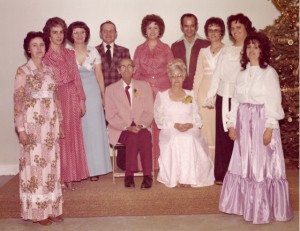
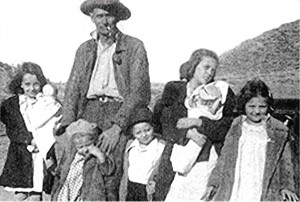 and boys didn’t sleep in the same bed. So, I could stay, but in Darla’s bed. It all worked out, and we had a great time, as I recall. Nevertheless, it was an event that I have never forgotten. Just like my sweet Aunt Dee is someone I will never forget, and I can’t wait to see again. Today would have been Aunt Dee’s 91st birthday. Happy birthday in Heaven, Aunt Dee. We love and miss you very much.
and boys didn’t sleep in the same bed. So, I could stay, but in Darla’s bed. It all worked out, and we had a great time, as I recall. Nevertheless, it was an event that I have never forgotten. Just like my sweet Aunt Dee is someone I will never forget, and I can’t wait to see again. Today would have been Aunt Dee’s 91st birthday. Happy birthday in Heaven, Aunt Dee. We love and miss you very much.
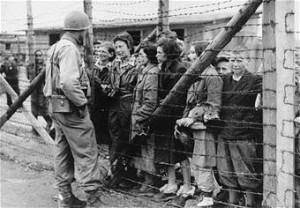 After years of being oppressed, starved, beaten, murdered, and used for experimentation, the Jewish people decided that it was their right to avenge their dead. The Nuremburg Trials were supposed to do all that, but so many of the Nazis had fled the country to escape the sentences they deserved, and once out of the country, it was almost impossible to get them back to face those sentences. In the late 1940s, under Juan Domingo Peron’s leadership (October 17, 1945 to July 1, 1974), the government secretly allowed entry of a number of war criminals fleeing Europe after Nazi Germany’s collapse, as part of the infamous ratlines. The number of Nazi fugitives that fled to Argentina surpassed 300, and included notorious war criminals such as Erich Priebke, Martin Bormann, Joseph Mengele, Eduard Roschmann, Josef Schwammberger, Walter Kutschmann, Otto Skorzeny and Holocaust administrator Adolf Eichmann, among others. In May 1960, Eichmann was kidnapped in Argentina by the Israeli Mossad and brought to trial in Israel. He was executed in 1962. At the time, Argentina condemned the Israeli government for abducting Eichmann, leading to a diplomatic spat between the nations.
After years of being oppressed, starved, beaten, murdered, and used for experimentation, the Jewish people decided that it was their right to avenge their dead. The Nuremburg Trials were supposed to do all that, but so many of the Nazis had fled the country to escape the sentences they deserved, and once out of the country, it was almost impossible to get them back to face those sentences. In the late 1940s, under Juan Domingo Peron’s leadership (October 17, 1945 to July 1, 1974), the government secretly allowed entry of a number of war criminals fleeing Europe after Nazi Germany’s collapse, as part of the infamous ratlines. The number of Nazi fugitives that fled to Argentina surpassed 300, and included notorious war criminals such as Erich Priebke, Martin Bormann, Joseph Mengele, Eduard Roschmann, Josef Schwammberger, Walter Kutschmann, Otto Skorzeny and Holocaust administrator Adolf Eichmann, among others. In May 1960, Eichmann was kidnapped in Argentina by the Israeli Mossad and brought to trial in Israel. He was executed in 1962. At the time, Argentina condemned the Israeli government for abducting Eichmann, leading to a diplomatic spat between the nations.
There was a financial incentive for Argentina to accept these war criminals, and they needed to provide a safe haven for them. Wealthy Germans and Argentine businessmen of German descent were willing to pay the way for escaping Nazis. The initial plan of the fleeing Nazis was to regroup, lay low for a while, and then come back with a vengeance. The Holocaust years had been very profitable for the Nazis. Nazi leaders had plundered untold millions from the Jews they murdered and some of that money accompanied them to Argentina…meaning the Argentine economy was helped by the war criminals…another incentive to help them hide out.
Some of the smarter Nazi officers and collaborators saw the writing on the wall as early as 1943 and began hiding gold, money, valuables, paintings, and more. They often moved their plunder to Switzerland. Ante Pavelic and his cabal of close advisors had several chests full of gold, jewelry, and art they had stolen from their Jewish and Serbian victims. These riches eased their passage to Argentina considerably. Disappearing, even in 1945 was not an easy matter, but if one had money, it was far more possible. The war criminals even paid off British officers to let them through Allied lines…a treasonous act for which those British officers should have 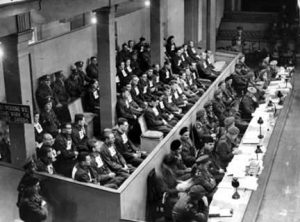 also been prosecuted and hung. Sometimes the corruption in government and military entities, even those who are supposed to be on the side of good, is absolutely astounding.
also been prosecuted and hung. Sometimes the corruption in government and military entities, even those who are supposed to be on the side of good, is absolutely astounding.
After the World War II, and the release of the surviving Jews, the Nuremburg Trials convicted these evil monsters, but many of them were gone before their sentence could be carried out. Enter the Nokmim, a group of Jewish men, also referred to as The Avengers or the Jewish Avengers. These men were a Jewish partisan militia, formed by Abba Kovner and his lieutenants Vitka Kempner and Rozka Korczak from the surviving remnants of the United Partisan Organization (Fareynikte Partizaner Organizatsye), which operated in Lithuania under Soviet command. Elements of the Nokmim collaborated with veterans of the Jewish brigade in British Palestine to form a new organization called Nakam, a group of assassins that targeted Nazi war criminals with the aim of avenging the Holocaust. The name comes from the phrase (Dam Yehudi Nakam – “Jewish Blood Will Be Avenged”) (the acronym DIN means “judgement”).
The Nakam (“vengeance”) Group was the most extremist group. They numbered around 60 Jews who were former Partisans, as well as other Jews who survived the Holocaust. This group was not about to let these men get away with all the atrocities they put their Jewish captives through, and then just walk away without punishment…not if they could help it. The group arrived in Germany after the war in order to conduct more complicated and fatal vengeance operations. Their ultimate purpose was to carry out an operation that would cause a broad international response…a warning, if you will, to anyone who might consider trying to harm Jews again, as the Nazis had. They needed to show the world that they would never be treated in such a way again. They would fight back…every time. Notables among the Hanakam group were Abba Kovner, Yitzhak Avidav, and Bezalel Michaeli. The group attempted a couple of mass poisonings, the first of the water supplies of Munich, Berlin, Weimar, Nuremberg and Hamburg, which failed when the poison had to be thrown overboard on a ship when Kovner was discovered to be carrying forges documents. The other attempt was with 3,000 loaves of bread painted with diluted arsenic, headed for 15,000 German POWs from the Langwasser internment camp near Nuremberg. The camp was under US authority. On April 23, 1946, it was reported that 2,283 German prisoners of war had fallen ill from poisoning, with 207 hospitalized and seriously ill. According to Harmatz, 300 to 400 Germans died. He said this “was nothing compared with what we really wanted to do.” A 2016 report by the Associated Press countered that the operation ultimately caused no known deaths, despite documents obtained through a Freedom of Information Act request to the National Archives and Records Administration 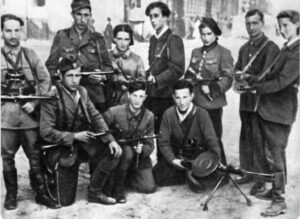 stating the arsenic found in the bakery was enough to kill approximately 60,000 persons. Apparently, the arsenic was spread too thin to be lethal.
stating the arsenic found in the bakery was enough to kill approximately 60,000 persons. Apparently, the arsenic was spread too thin to be lethal.
It’s hard to say just how much information is correct and how much is incorrect. I suppose it depends on who is reporting, and how accurately they want to report what they have. Propaganda in any war runs rampant, so we will likely never know. Records can and do go missing, especially when someone wants to disprove their enemies. Whether so many people died by poisoning or not, the Nokmim and the spin-off Nakam brought vengeance on many of the Nazis who would have escaped justice without them.
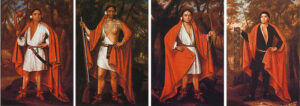 The New World (later the United States of America) was a pretty rough place in 1710. Great Britain owned a small portion of the whole of the New World, and the rest was often vied for against the French and other nations. That year, the mayor of Albany, New York, Pieter Schuyler, arranged a meeting between Queen Anne and five Indian Kings who wanted to request her aid, militarily. The Four Indian Kings or Four Kings of the New World were three Mohawk chiefs from one of the Five Nations of the Iroquois Confederacy and a Mahican of the Algonquian peoples. Five chiefs set out on the journey, but one died in mid-Atlantic. The three Mohawk Kings were Sa Ga Yeath Qua Pieth Tow of the Bear Clan, called King of Maquas, with the Christian name Peter Brant (grandfather of Mohawk leader Joseph Brant); Ho Nee Yeath Taw No Row of the Wolf Clan, called King of Canajoharie (“Great Boiling Pot”), or John of Canajoharie; and Tee Yee Ho Ga Row, meaning “Double Life”, of the Wolf Clan, also called Hendrick Tejonihokarawa or King Hendrick. The Mahican chief was Etow Oh Koam of the Turtle Clan, mistakenly identified in his portrait as Emperor of the Six Nations. The Algonquian-speaking Mahican people were not part of the Iroquois Confederacy.
The New World (later the United States of America) was a pretty rough place in 1710. Great Britain owned a small portion of the whole of the New World, and the rest was often vied for against the French and other nations. That year, the mayor of Albany, New York, Pieter Schuyler, arranged a meeting between Queen Anne and five Indian Kings who wanted to request her aid, militarily. The Four Indian Kings or Four Kings of the New World were three Mohawk chiefs from one of the Five Nations of the Iroquois Confederacy and a Mahican of the Algonquian peoples. Five chiefs set out on the journey, but one died in mid-Atlantic. The three Mohawk Kings were Sa Ga Yeath Qua Pieth Tow of the Bear Clan, called King of Maquas, with the Christian name Peter Brant (grandfather of Mohawk leader Joseph Brant); Ho Nee Yeath Taw No Row of the Wolf Clan, called King of Canajoharie (“Great Boiling Pot”), or John of Canajoharie; and Tee Yee Ho Ga Row, meaning “Double Life”, of the Wolf Clan, also called Hendrick Tejonihokarawa or King Hendrick. The Mahican chief was Etow Oh Koam of the Turtle Clan, mistakenly identified in his portrait as Emperor of the Six Nations. The Algonquian-speaking Mahican people were not part of the Iroquois Confederacy.
When the kings arrived in London, they were treated like diplomats. They were transported through the streets of the city in Royal carriages and received by Queen Anne at the Court of Saint James Palace. They visited the Tower of London and Saint Paul’s Cathedral as well, and they got to tour and do things all over London to honor their visit. They watched a review of the Guards in Hyde Park, visited the Banqueting House and Chapel at Whitehall, and they were taken on the Queen’s barge to Greenwich Hospital and the Woolwich Arsenal, where they heard a saluting cannonade. They listened to sermons in the city’s churches. They were guests of 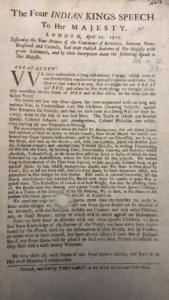 honor at a dinner hosted by the Board of Trade and were privately entertained by William Penn at the Taverne du Diable at Charing Cross. They attended a performance of Powell’s Marionettes at Punch’s Theater; a presentation of Macbeth where they got to sit on the stage. I’m sure the people of the city were quite curious about these “wild men” who had come to their city. Their clothing was so different from the sophisticated garb that was normally seen gracing the royal carriages. Still, the Indians were probably wearing their finest clothing too, and in the New World, it was probably top of the line. The queen wanted to commemorate the diplomatic visit, so the Crown commissioned Jan Verelst to paint the portraits of the Four Kings. These paintings hung in Kensington Palace until 1977, when Queen Elizabeth II had them relocated to the National Archives of Canada. She unveiled them in Ottawa.
honor at a dinner hosted by the Board of Trade and were privately entertained by William Penn at the Taverne du Diable at Charing Cross. They attended a performance of Powell’s Marionettes at Punch’s Theater; a presentation of Macbeth where they got to sit on the stage. I’m sure the people of the city were quite curious about these “wild men” who had come to their city. Their clothing was so different from the sophisticated garb that was normally seen gracing the royal carriages. Still, the Indians were probably wearing their finest clothing too, and in the New World, it was probably top of the line. The queen wanted to commemorate the diplomatic visit, so the Crown commissioned Jan Verelst to paint the portraits of the Four Kings. These paintings hung in Kensington Palace until 1977, when Queen Elizabeth II had them relocated to the National Archives of Canada. She unveiled them in Ottawa.
The four kings were quite a spectacle in London, they were all described in a contemporary pamphlet as being in shape, muscular and within an inch or two of being six feet tall. Their complexions were described as being brown and their hair long and black.” Their visages are very awful and majestick, and their features regular enough, though something of the austere and sullen.” Their faces are covered in art, probably meant to inspire terror during battle. They are described as polite, they will not refuse any drink or food that is offered to them. They loved English beef more than any other kind of food offered to them. The people of London also described them as healthy. “Their health is good, as is proper for primitives; they know no gout, dropsy, gravel, or fevers.”
While I’m sure the big city was awe inspiring for the Kings, they were really there on a mission…to requesting military aid for defense against the French, and the chiefs to ask for missionaries to offset the influence of French Jesuits, who had converted numerous Mohawk to Catholicism. When they met with Queen Anne the court was mourning for the death of the Prince of Denmark, so the four Indian Kings were dressed in all black attire when they met with her. Their address to her was read, they asked for military assistance and missionaries to lead them to “true religion.” After the reading, the chiefs presented the queen with several belts of wampum to signify their meeting. In return for the gifts of the wampum, the queen gave them a set of communion plates, with the royal cipher and coat of arms, for a future Mohawk chapel. (These are now divided between the Mohawk reservations at Brantford, Ontario, and Tyendinaga, near Kingston.) The Archbishop of Canterbury gave each of the chiefs a Bible bound in Turkey-red leather. When she heard their request, Queen Anne informed the Archbishop of Canterbury, Thomas Tenison. They authorized a mission, and Mayor Schuyler 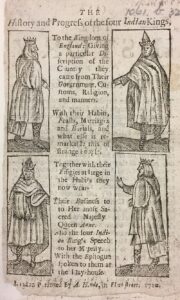 had a chapel built the next year at Fort Hunter (located near the Mohawk “Lower Castle” village) along the Mohawk River. The queen also engaged the four men in conversation through their interpreter, Peter Schuyler’s brother, John. Queen Anne was very generous to the Kings and their people, sending a gift of a silver Communion set and a reed organ. The Mohawk village known as the “Lower Castle” became mostly Christianized village in the early 18th century, unlike the “Upper Castle” at Canajoharie further upriver, where there was no mission founded until 1769, when William Johnson, British agent to the Iroquois, built the Indian Castle Church, which still stands today.
had a chapel built the next year at Fort Hunter (located near the Mohawk “Lower Castle” village) along the Mohawk River. The queen also engaged the four men in conversation through their interpreter, Peter Schuyler’s brother, John. Queen Anne was very generous to the Kings and their people, sending a gift of a silver Communion set and a reed organ. The Mohawk village known as the “Lower Castle” became mostly Christianized village in the early 18th century, unlike the “Upper Castle” at Canajoharie further upriver, where there was no mission founded until 1769, when William Johnson, British agent to the Iroquois, built the Indian Castle Church, which still stands today.
During their visit to London, the Kings were lodged at The Crown and Cushion, in King Street, Covent Garden. Here they slept on beds for the first time and became accustomed to them. Thomas Arne was their host, he was an inn keep and an upholsterer, he was very kind and considerate to his visitors. Because of this, the Indians renamed him Cataraqui in a Mohawk christening ceremony. Cataraqui was the fort that has now become the city of Kingston, Ontario. I’m sure that they really missed those beds when they returned to the New World in May of 1710.
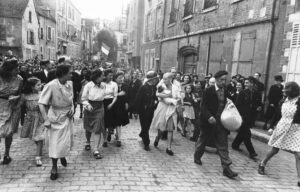 Having a baby is normally a blessed event, but it is also important to be having the baby with the right person. I know that sound like something that is between the man and the woman, and it’s nobody’s business but their own, and I would agree with you on that. However, during World War II, the Nazi regime was so hated that the nations they terrorized didn’t want anything to do with them…so much so that French women having babies with German soldiers were punished by shaving their heads bald and parading them through town. This was done so that everyone would know they betrayed their country, and so they had.
Having a baby is normally a blessed event, but it is also important to be having the baby with the right person. I know that sound like something that is between the man and the woman, and it’s nobody’s business but their own, and I would agree with you on that. However, during World War II, the Nazi regime was so hated that the nations they terrorized didn’t want anything to do with them…so much so that French women having babies with German soldiers were punished by shaving their heads bald and parading them through town. This was done so that everyone would know they betrayed their country, and so they had.
The Nazi regime was set on creating “the perfect race,” in their opinion anyway. They wanted everyone to be light skinned, blond haired, and blue eyed, and those who weren’t had to prove their genetic lines. The Nazis even went so far as to set up places that women (of the right bloodlines) were sent to have their children, conceived with German soldiers. Then, the plan was that they would give their children up for adoption by a Nazi couple who was having trouble conceiving. It was Hitler’s way of preserving the “right” bloodline. Many times, if the woman changed her mind, and wanted to keep the baby, but refused to marry the soldier, their babies were taken from the by force, even if it meant taking their lives. Some of these 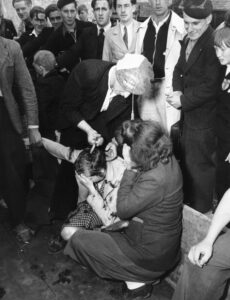 women were in it for the money and had no intention of keeping their babies. They were a simply a “Nazi Baby Machine.”
women were in it for the money and had no intention of keeping their babies. They were a simply a “Nazi Baby Machine.”
Once it was discovered that these women were doing this, they were marked as traitors. Often their own families disowned them. These women might not even be having babies with the Nazi soldiers, just having relations with them. The soldiers saw nothing wrong with hooking up with these women to ply them for information. It was an act of treason on the part of the women. They shouldn’t have allowed themselves to become involved with the Nazi soldiers, because they just had to know that was wrong. Treason is such a dark side of war. Still, there are many dark sides to war, and in most cases, it is the innocent and oppressed that suffer.
The French resistance brought out another dark side to the war, and it was rather brutal, but they felt like it was justified. Looking at it now, I think the beating part was the probably brutal, but maybe still have been justified. Basically, the French Resistance, when women were caught in a physical relationship with a Nazi, shaved their heads, beat the women who had been charged with collaborating with the enemy, and then paraded them around town as a form of punishment. The punishment was followed by harassing the women, with no repercussion for the beatings, head shavings, or the harassing. In France, a woman’s long hair is supposed to be seductive, so shaving their heads, was a way to make them look undesirable. The practice dates back to Biblical times. It was a common punishment for adultery. During the 20th century, it was reintroduced as a means to ridicule women who had physical relationships with the enemy or were prostitutes. 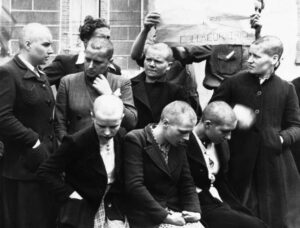 The French Resistance took a page from Bible times, and so it came to pass that during World War II, this act of humiliation was repeated on French women accused of collaborating with the German soldiers. Apart from shaving their heads, they were paraded in the streets, marked with black ink, and even stripped half-naked. At least 20,000 women have been documented to have had their heads shaved. I’m not a proponent of violence, but traitors need to be punished, and after something like that, I would think these women would think twice before getting involved with the Nazi soldiers. and any woman who hadn’t done so, would think twice before even considering such a heinous act.
The French Resistance took a page from Bible times, and so it came to pass that during World War II, this act of humiliation was repeated on French women accused of collaborating with the German soldiers. Apart from shaving their heads, they were paraded in the streets, marked with black ink, and even stripped half-naked. At least 20,000 women have been documented to have had their heads shaved. I’m not a proponent of violence, but traitors need to be punished, and after something like that, I would think these women would think twice before getting involved with the Nazi soldiers. and any woman who hadn’t done so, would think twice before even considering such a heinous act.
 Whenever a ship sinks, it takes with it a lot of gear, personal effects, and sometimes treasures. These days, they send in the submarines, or rather the mini submarines to salvage whatever they can, find out what caused the sinking, and sometimes to aid in raising the ship to the surface. In times past, when a ship went down, it could easily be lost forever, or at least until more modern times when they could finally find it again.
Whenever a ship sinks, it takes with it a lot of gear, personal effects, and sometimes treasures. These days, they send in the submarines, or rather the mini submarines to salvage whatever they can, find out what caused the sinking, and sometimes to aid in raising the ship to the surface. In times past, when a ship went down, it could easily be lost forever, or at least until more modern times when they could finally find it again.
When the Vasa, an amazingly beautiful Swedish warship that sank on its maiden voyage, 1400 yards into its voyage sat in the harbor for years. The did manage to get the cannon from it right away, but everything else sat underwater until the 1950s, when they had a better way to salvage it. When the world’s first completely covered underwater diving suit was invented around 1715, it consisted of an airtight oak barrel. The suit was used mainly for salvage operations of shipwrecks. I wonder what they could have done with Vasa using that. Vasa wasn’t in dangerously deep water, and could have been accessed easily today, but they just didn’t have the equipment.
The cross between a diving bell and standard diving dress is rather interesting. I wonder if the barrel design John Lethbridge used in 1715 was seriously difficult to move in. It reminds me a of a comical space suit, but I guess it served its purpose. However odd it is, it was the first underwater diving suit, and it is currently located in the Cité de la Mer, a maritime museum in Cherbourg, France.
Lethbridge came up with the idea for his diving suit while working for the East India Company as a salvager. The barrel was airtight, so the diver was protected and safe. The barrel was six feet in length, and the diver had little control of it once it was lowered into the water. The diver had to lay flat on his stomach once the barrel. The barrel had two airtight holes on the sides for the diver’s hands and a hole with glass in the front for use as the diver’s viewing window. During trials, Lethbridge demonstrated that the suit enabled divers to stay 12 fathoms (a unit of length equal to six feet) underwater for at least 30 minutes at a time. That was hard for 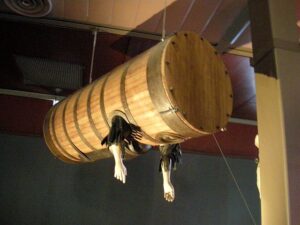 me to figure out, until I read that once the diver comes out of the water after 30 minutes, the crew pumped fresh air into the suit through a vent using bellows. At the same time, the used air was let out through another vent. Then, with the fact that the barrel was airtight, the diver was good for another 30 minutes. It wasn’t perfect, but it was much further along than salvage operations had been before it. The suit, while odd and very primitive was an immediate success. It was used mostly to retrieve material from shipwrecks. During Lethbridge’s first salvage…the maiden voyage of the diving suit, as it were, Lethbridge recovered 25 chests of silver and 65 cannons! I would call that a definite success.
me to figure out, until I read that once the diver comes out of the water after 30 minutes, the crew pumped fresh air into the suit through a vent using bellows. At the same time, the used air was let out through another vent. Then, with the fact that the barrel was airtight, the diver was good for another 30 minutes. It wasn’t perfect, but it was much further along than salvage operations had been before it. The suit, while odd and very primitive was an immediate success. It was used mostly to retrieve material from shipwrecks. During Lethbridge’s first salvage…the maiden voyage of the diving suit, as it were, Lethbridge recovered 25 chests of silver and 65 cannons! I would call that a definite success.

